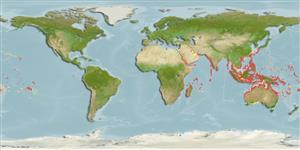Environment: milieu / climate zone / depth range / distribution range
экология
морской; солоноватоводный ассоциированный с рифами; пределы глубины 0 - 30 m (Ref. 128797). Tropical; 22°C - 28°C; 32°N - 35°S, 20°E - 130°W
Indo-Pacific: Red Sea and East Africa and Persian Gulf (Ref. 68964) to the Tuamoto Islands, north to southern Japan, south to northern Australia and New Caledonia. Recorded off the coast of Florida in the Western Central Atlantic (Ref. 51238).
Size / Вес / Возраст
Maturity: Lm ? range ? - ? cm
Max length : 60.0 cm TL самец/пол неопределен; (Ref. 5450)
колючие лучи спинного плавника (общее число): 5; членистые (мягкие) лучи спинного плавника (общее число): 34-39; колючие лучи анального плавника 3; членистые (мягкие) лучи анального плавника: 25 - 29. The ocular band of adult specimens with a series of dark vermiculations (Ref. 1602). Adults (above 20 cm) yellowish silvery or dusky, dark bar through eye and another bar just behind head. Occasionally with a few small, scattered black spots on body. Median fins yellowish, with black margins posteriorly. Pelvic fins black. Small juveniles reddish brown, with irregular black spots and blotches and small, white (black-edged) ocelli on body. Small black spot at base of last 3 dorsal- and anal-fin rays. Caudal fin transparent except for base, which is reddish brown. Body orbicular and strongly compressed, its depth more than twice length of head and 0.9 to 1.4 times SL. Head length 3.4 to 3.8 times SL. Snout profile of large adults (above 40 cm total length) concave, with bony swelling between eyes. Interorbital width 38 to 48% head length. Jaws with bands of slender, flattened, tricuspid teeth, the middle cusp about twice length of lateral cusps. No teeth on palatines or vomer. Five pores on each side of lower jaw. Preopercle smooth. Opercle without spines (Ref 43039).
Live in shallow protected coastal waters to deep, somewhat silty habitats. Often with deep shipwrecks (Ref. 48637). Adults are found singly or in small groups and occasionally in large schools in some areas. Juveniles occur singly or in small groups among mangroves and inner sheltered lagoons while adults move out to open waters over sandy areas of deep lagoons, channels, and seaward reefs to a depth of at least 30 m. Feed on algae, invertebrates and small fishes (Ref. 89972).
Life cycle and mating behavior
половая зрелость | размножение | нерест | икра | Fecundity | личинки
Myers, R.F., 1991. Micronesian reef fishes. Second Ed. Coral Graphics, Barrigada, Guam. 298 p. (Ref. 1602)
Статус Красного Списка МСОП (Ref. 130435)
Угроза для людей
Harmless
Использование человеком
рыболовство: не имеет хозяйственного значения; аквакультура (рыбоводство): коммерческий; аквариум: коммерческий
дополнительная информация
народные названиясинонимыобмен веществхищникиэкотоксикологияразмножениеполовая зрелостьнерестSpawning aggregationFecundityикраРазвитие икры
инструменты
Специальные отчеты
Скачать в формате XML
ресурсы в Интернет
Estimates based on models
Preferred temperature (Ref.
123201): 24.9 - 29.2, mean 28.5 °C (based on 3165 cells).
Phylogenetic diversity index (Ref.
82804): PD
50 = 0.5313 [Uniqueness, from 0.5 = low to 2.0 = high].
Bayesian length-weight: a=0.03236 (0.01630 - 0.06426), b=2.95 (2.77 - 3.13), in cm total length, based on LWR estimates for this species & (Sub)family-body (Ref.
93245).
Trophic level (Ref.
69278): 3.3 ±0.49 se; based on food items.
устойчивость к внешним воздействиям (Ref.
120179): средний (среднего размера), минимальное время удвоения популяции 1.4-4.4 года (Preliminary K or Fecundity.).
Fishing Vulnerability (Ref.
59153): Moderate vulnerability (44 of 100).
Nutrients (Ref.
124155): Calcium = 35.1 [18.3, 56.0] mg/100g; Iron = 0.48 [0.30, 0.77] mg/100g; Protein = 19 [18, 20] %; Omega3 = 0.0993 [, ] g/100g; Selenium = 32.3 [18.4, 59.2] μg/100g; VitaminA = 41.7 [11.6, 145.4] μg/100g; Zinc = 1.13 [0.79, 1.61] mg/100g (wet weight);
